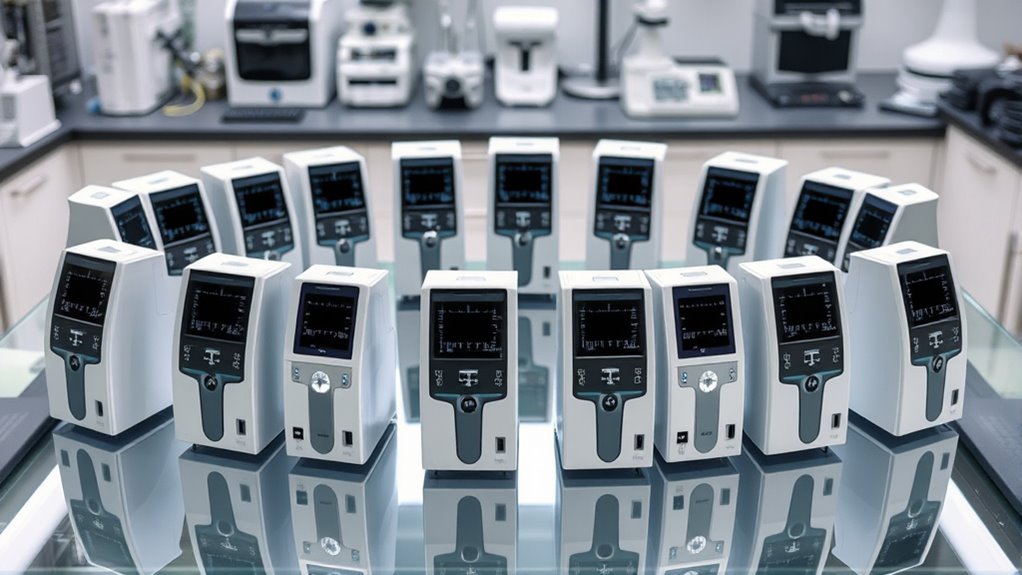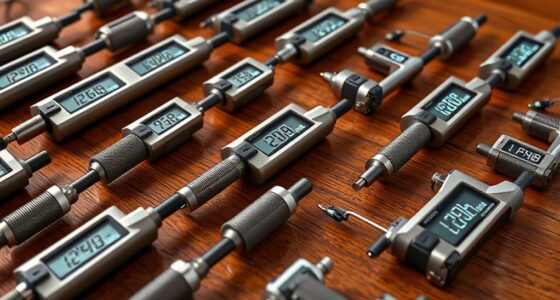If you’re looking for the top X-ray fluorescence analyzers of 2025, I’ve got you covered. The best picks include portable precious metal analyzers for gold, silver, and platinum, hand-held XRF devices for industrial testing, and advanced systems like the Elite Handheld XRF for alloys and minerals. Plus, there are compact UV spectrometers, rugged flaw detectors, and high-end spectrophotometers for molecular analysis. Keep exploring, and you’ll discover more about these cutting-edge tools and what makes them stand out.
Key Takeaways
- The Elite Handheld XRF offers rapid multi-element analysis with ±0.003% accuracy, suitable for jewelry, mining, and recycling.
- Portable X-ray flaw detectors like TMXG-35 provide non-destructive structural testing in demanding industrial environments.
- Advanced XRF sulfur analyzers, such as SYD-17040A, enable quick on-site oil sulfur content testing within 30 seconds.
- Certified portable XRF devices feature rugged designs, waterproof IP67 ratings, WiFi/Bluetooth connectivity, and ease of use for field applications.
- Expert reviews prioritize devices with high sensitivity, reliability, certification compliance, and user-friendly interfaces for diverse industrial needs.
Precious Metal Analyzer for Gold, Silver, Platinum, Palladium
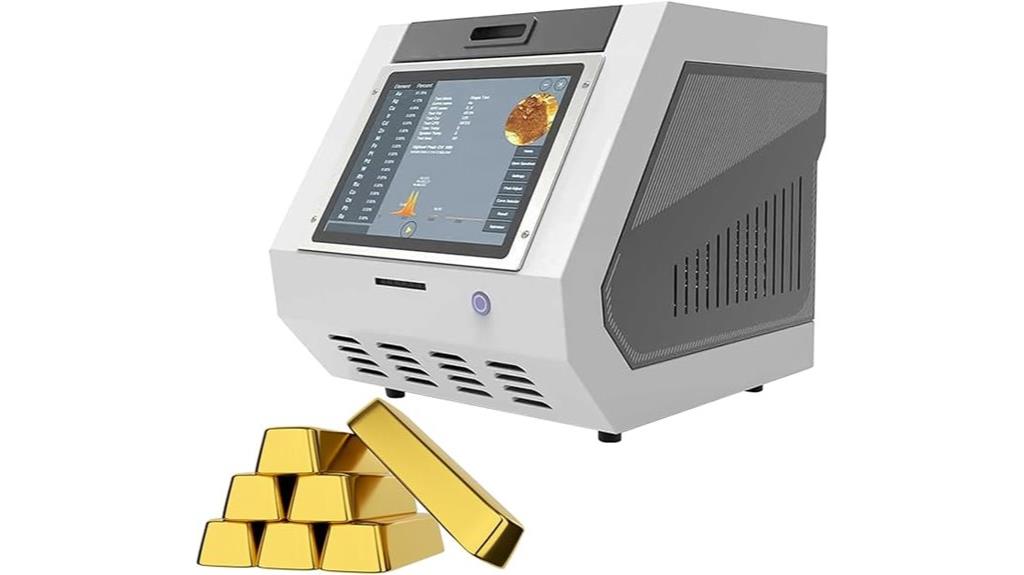
If you’re in the jewelry or recycling business, the Precious Metal Analyzer for gold, silver, platinum, and palladium is an essential tool because it offers fast, non-destructive testing with a detection sensitivity of just 10ppm. It quickly identifies precious metals in solid samples, making it perfect for retail, pawnshops, and recycling centers. Its advanced features include a gas proportional detector, customizable filters, and an adjustable X-ray tube ranging from 5-50kV. Compact and lightweight, it’s easy to move around your workspace. Certified with CE and FCC standards, this analyzer guarantees safe, reliable, high-precision results, streamlining your metal testing process.
Best For: jewelry manufacturers, pawnshops, and recycling centers seeking quick, accurate, and non-destructive precious metal testing.
Pros:
- High sensitivity detection of 10ppm for precise metal identification
- Portable and lightweight design for easy use in various settings
- Certified with CE and FCC standards ensuring safety and reliability
Cons:
- Limited to solid samples; may not be suitable for very small or irregularly shaped items
- Requires stable power supply and controlled environment for optimal accuracy
- Initial cost might be high for small-scale users or hobbyists
Handheld XRF Analyzer for Metal & Industrial Testing

The Handheld XRF Analyzer for Metal & Industrial Testing stands out as an essential tool for professionals who need rapid, accurate, non-destructive analysis in the field. Its high-precision 25-element detection covers metals from titanium to bismuth, making it ideal for quality control, mining, and alloy verification. Powered by an Android-based system, it offers real-time data, remote operation, and easy report sharing. With a lightweight design, a robust 6800mAh battery for up to six hours of continuous use, and GPS integration, it’s built for on-the-go industrial environments. This analyzer combines portability with reliable, high-accuracy elemental analysis, making it a top choice for metal professionals in 2025.
Best For: professionals in metalworking, mining, quality control, and alloy analysis seeking rapid, accurate, and non-destructive field testing of various metals and alloys.
Pros:
- High-precision detection of up to 25 elements from Ti to Bi for comprehensive analysis
- Android-based system with real-time data, remote operation, and easy report sharing
- Long-lasting 6800mAh battery provides up to 6 hours of continuous testing in the field
Cons:
- May require familiarity with advanced analytical equipment for optimal use
- The device’s cost could be prohibitive for small-scale or budget-conscious users
- Limited to metal and alloy testing, not suitable for non-metallic materials
Elite Handheld XRF Analyzer for Alloy & Mineral Testing

When precision and speed are critical in alloy and mineral testing, the Elite Handheld XRF Analyzer stands out. It delivers results in just 0.8 seconds, detecting over 40 elements like Ti, Cr, Ni, Au, Pt, and Pd with ±0.003% accuracy. Its advanced technology guarantees lab-quality precision with detection limits as low as 0.1ppm. Compact, lightweight, and rugged, it’s designed for demanding environments, featuring IP67 waterproof protection and a 7-inch OLED display. With WiFi 6E and Bluetooth 5.3, it supports seamless cloud data transfer, backed by an 8-year warranty and certified safety standards. This analyzer is ideal for alloy and mineral professionals needing reliable, fast results.
Best For: professionals in mining, recycling, metallurgy, and alloy testing seeking rapid, precise, and durable handheld analysis tools.
Pros:
- lightning-fast analysis in just 0.8 seconds with high accuracy (+/-0.003%)
- rugged, waterproof design with IP67 certification suitable for extreme environments
- supports real-time cloud data transfer via WiFi 6E and Bluetooth 5.3, ensuring seamless integration
Cons:
- requires manual power input despite having a built-in 12-hour battery backup
- relatively heavy at 4.2 pounds, which may affect portability during extended field use
- higher initial investment cost due to advanced features and certifications
Portable UV Spectrometer Analyzer (JDY-F2300)
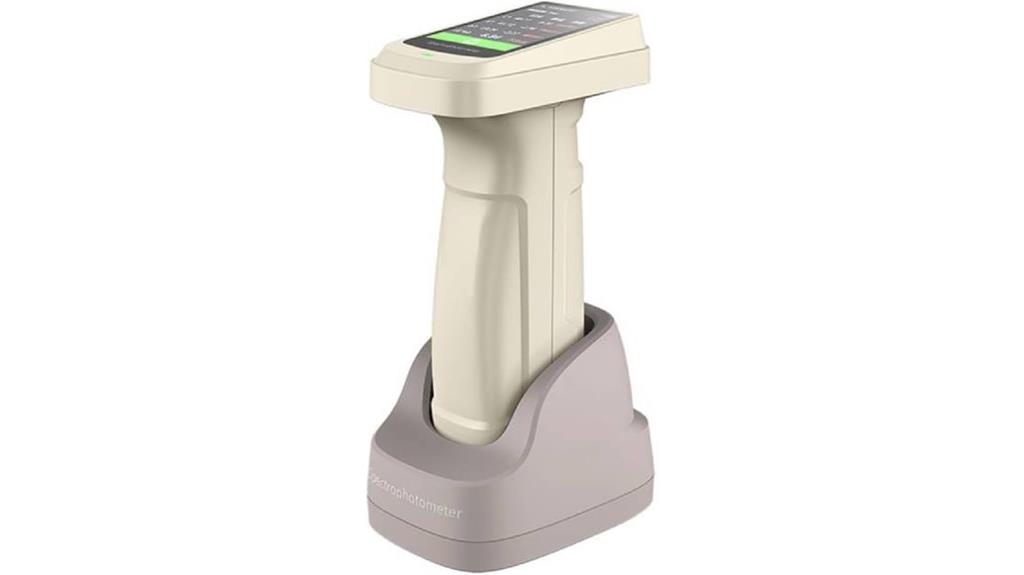
The Portable UV Spectrometer Analyzer (JDY-F2300) stands out for its automatic calibration feature, which guarantees precise measurements without the need for manual adjustments. Its double light road sensor array ensures high accuracy across a broad spectral range, supporting over 30 measurement parameters and 37 evaluation light sources. Designed as a handheld device with a compact, lightweight form, it features a full-color IPS screen and quick measurement times of around 1-1.5 seconds. Compatible with USB connections and software, it seamlessly integrates into various workflows. Ideal for diverse sample types, the JDY-F2300 offers reliable, fast, and versatile spectral analysis in a portable format.
Best For: professionals and researchers needing rapid, precise spectral analysis across diverse sample types in laboratory or field environments.
Pros:
- Supports automatic calibration for accurate measurements without manual intervention.
- Features a broad spectral range (360-700nm) with multiple measurement parameters and evaluation light sources.
- Compact, lightweight design with quick measurement times and versatile connectivity options.
Cons:
- Limited to a measuring diameter of 8mm, which may not suit larger sample sizes.
- Requires USB connection and compatible software, potentially limiting use without compatible devices.
- Availability depends on the product release date and stock, which may affect immediate procurement.
Portable X-ray Flaw Detector TMXG-35
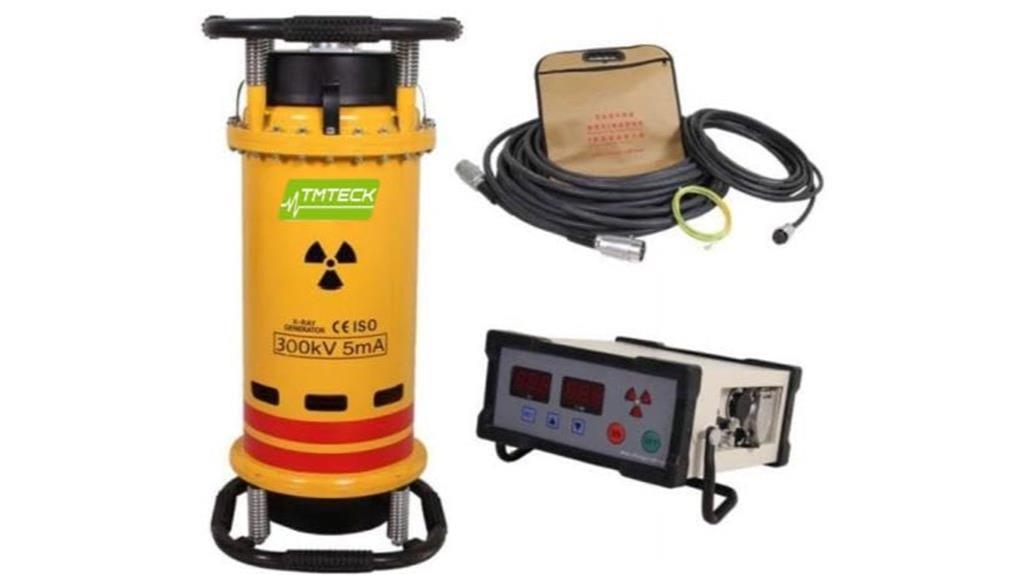
If you need a reliable, portable solution for non-destructive testing in demanding industrial environments, the Portable X-ray Flaw Detector TMXG-35 stands out as an excellent choice. Designed specifically for industries like shipbuilding, machinery manufacturing, aviation, and oil, it guarantees accurate flaw detection on-site. Its rugged build makes it suitable for construction sites and high-altitude operations, providing dependable performance where it matters most. This device offers precise imaging to identify structural flaws without causing damage, helping you maintain safety and quality standards efficiently. Overall, the TMXG-35 is a robust, versatile tool for critical industrial inspections.
Best For: professionals in shipbuilding, machinery manufacturing, aviation, and other heavy industries needing reliable, on-site non-destructive flaw detection.
Pros:
- Portable and rugged design suitable for construction sites and high-altitude environments
- Accurate imaging for precise flaw identification without damaging materials
- Widely applicable across multiple demanding industrial industries
Cons:
- Not intended for medical or clinical use
- May require specialized training for optimal operation
- Potentially higher cost compared to simpler testing devices
SYD-17040A Portable XRF Sulfur Analyzer

Designed for on-site oil sulfur analysis, the SYD-17040A Portable XRF Sulfur Analyzer stands out with its rapid results and portability. Using advanced energy dispersive X-ray fluorescence technology, it accurately measures sulfur levels from 50 ppm to 5%, making it ideal for petroleum and chemical samples. Weighing just 13 kg, it’s easy to carry into the field. It delivers results within 30 seconds using only 3-5 ml of oil, supporting quick decision-making. Its reliable performance, with excellent repeatability and reproducibility, operates well in various environmental conditions. The user-friendly interface simplifies operation, making it perfect for refineries, pipelines, and on-site quality control.
Best For: refineries, pipelines, and laboratories seeking rapid, accurate on-site sulfur analysis of petroleum and chemical samples.
Pros:
- Rapid measurement results within 30 seconds, enhancing workflow efficiency
- Portable design weighing only 13 kg for easy field transportation
- Wide detection range from 50 ppm to 5%, suitable for diverse sample types
Cons:
- Operates effectively only within specific temperature (10-30°C) and humidity (<85%) conditions
- Limited to sulfur analysis; does not provide comprehensive petrochemical testing
- Requires a small sample volume (3-5 ml), which may be restrictive for some testing protocols
C160

The C160 stands out as a top choice for professionals diagnosing gas appliances thanks to its up to 10-year warranty with annual recertification. Its features include low flow detection, ensuring accurate readings, and 30 memory slots to store test data easily. With 8 pre-programmed fuel types, it offers versatile testing for various systems. The C160 is simpler to operate than previous HVAC meters, making adjustments to gas valves straightforward. It’s designed specifically for gas appliance diagnostics, helping technicians fine-tune and test gas valves quickly and accurately, ultimately streamlining maintenance and ensuring safety.
Best For: HVAC professionals and technicians diagnosing and fine-tuning gas appliances for accurate, efficient, and safe operation.
Pros:
- Up to 10-year warranty with annual recertification ensures long-term reliability
- Low flow detection and 30 memory slots facilitate accurate readings and data management
- User-friendly design simplifies gas valve adjustments and testing across various systems
Cons:
- Limited to gas appliance diagnostics, not suitable for other HVAC or plumbing tasks
- May require training to maximize the benefits of its features and settings
- Specific fuel type presets might need updates for new or uncommon system types
High Performance F97XP Spectrophotometer
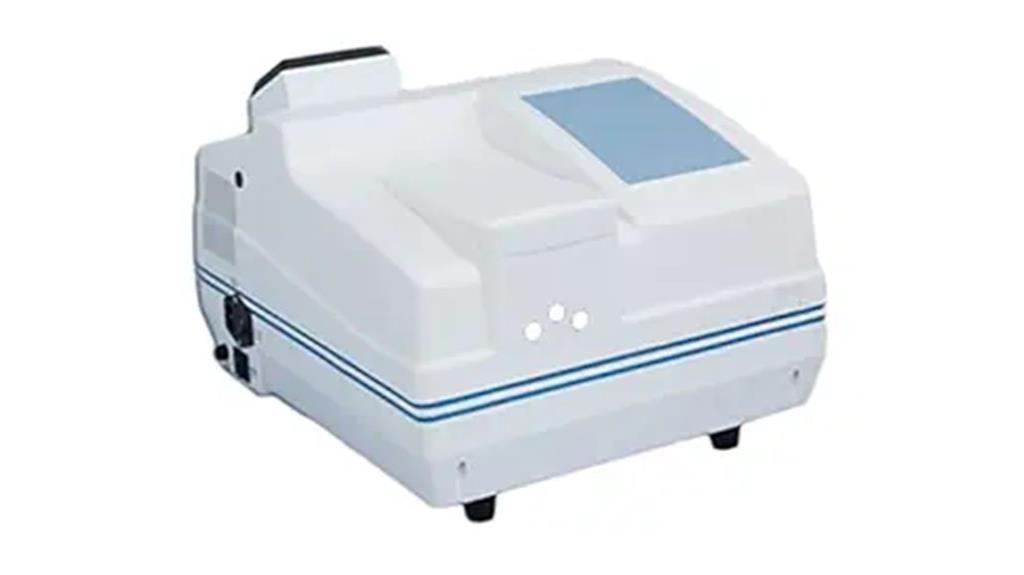
The High Performance F97XP Spectrophotometer stands out for its rapid data acquisition, thanks to a maximum wavelength scan speed of 48,000 nm/min. This speed allows me to quickly analyze samples across a wide spectral range of 200–900 nm, making it ideal for diverse applications like pharmaceutical, water quality, and food safety testing. Its high detection sensitivity and stable fluorescence signals ensure precise, reliable results. With advanced features like adjustable slit options and a robust Xenon light source, I can perform high-end analyses efficiently. Compact and user-friendly, the F97XP meets demanding industry standards for speed, accuracy, and stability.
Best For: researchers and professionals in pharmaceutical, biochemical, water quality, and food safety laboratories seeking rapid, sensitive, and accurate fluorescence analysis.
Pros:
- Fast maximum wavelength scan speed of 48,000 nm/min enables rapid data collection
- High detection sensitivity and stable fluorescence signals ensure precise results
- Wide spectral measurement range (200–900 nm) and customizable slit options support versatile applications
Cons:
- Power consumption of 200W may require dedicated electrical setup
- Compact size might limit integration into larger automated analytical systems
- Advanced features and high sensitivity may entail higher maintenance or calibration needs
High Performance F97Pro Spectrophotometer

For researchers seeking rapid and highly sensitive fluorescence measurements, the High Performance F97Pro Spectrophotometer stands out with its blazing-fast scanning speed and exceptional signal quality. It covers a broad wavelength range from 200 to 900 nm, ensuring versatile analysis. Its advanced optical design and weak signal detection technology deliver high sensitivity, with a water Raman peak signal-to-noise ratio over 200. Equipped with a high-powered Xenon light source and photoelectric detectors, it guarantees strong light intensity and detection accuracy. Thanks to a high-speed digital processing unit, it can generate spectra in just 1 second, making high-throughput analysis both efficient and reliable.
Best For: researchers and laboratories requiring rapid, high-sensitivity fluorescence measurements across a broad spectral range from 200 to 900 nm.
Pros:
- Exceptional scanning speed of 48,000 nm/min for high-throughput analysis
- High water Raman peak signal-to-noise ratio exceeding 200 for reliable results
- Advanced optical design and weak signal detection technology ensure high sensitivity and measurement accuracy
Cons:
- The powerful 200W light source may require careful handling and maintenance
- Potentially higher cost due to advanced features and high-performance components
- Larger size and complexity might necessitate specialized training for optimal operation
FV-2009 Industrial X-Ray Radiography Film Viewer Portable LED 2.4 x 8 inch

If you need a portable X-ray film viewer that combines high luminance with durability, the FV-2009 from M&A Instruments stands out as a top choice. This lightweight device features a 2.4 x 8 inch viewing window, perfect for detailed flaw detection. Its LED illumination delivers an impressive 103,000 Cd/m² luminance, ensuring clear image assessment under various conditions. Built mainly from durable plastic, it’s certified for industrial use and includes a foot pedal for easy operation. With a lifespan exceeding 50,000 hours, it offers reliable performance day after day. Despite minor concerns about the foot switch, most users praise its portability and consistent lighting quality.
Best For: professionals in industrial radiography and nondestructive testing seeking a durable, high-luminance portable film viewer for detailed flaw detection.
Pros:
- High luminance of 103,000 Cd/m² ensures clear, detailed image review
- Lightweight and durable plastic construction for portability and long-term use
- Includes a foot pedal for easy, hands-free operation and adjustable light intensity
Cons:
- Foot switch may not fully turn off the light, only reducing brightness to a minimum
- No batteries included; requires external power source for operation
- Regional plug compatibility may require adapters for use in different areas
Sigma Metalytics Pro SM2701 with All 3 Wands, Black, grey
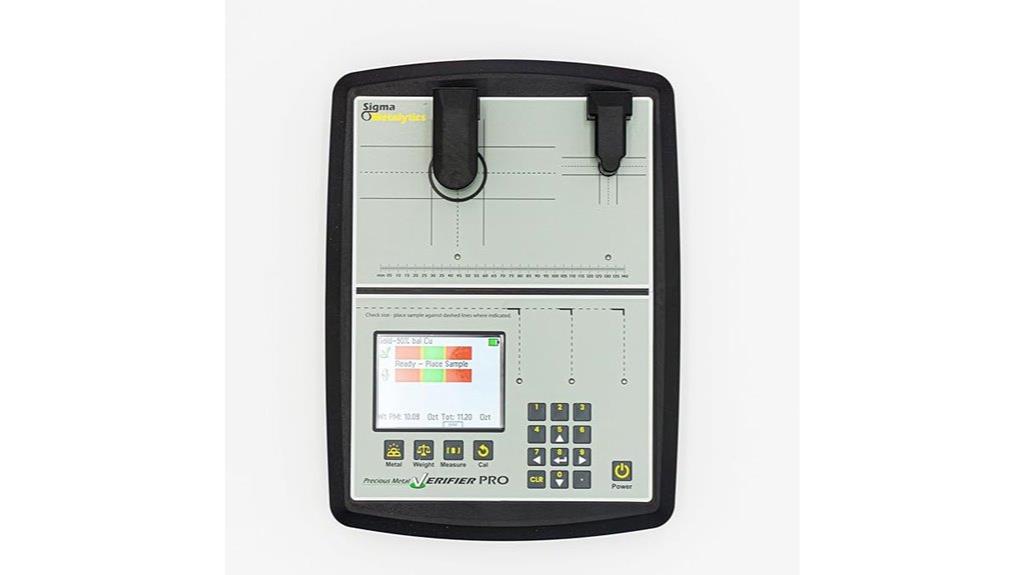
Designed for professional buyers and sellers, the Sigma Metalytics Pro SM2701 with All 3 Wands offers precise, non-invasive verification of precious metals without damaging samples. It includes a robust unit, three different wand attachments, an external bridge for thick bars, and a protective case. Capable of testing from 1/20 oz gold to 100 oz silver, it provides thru readings, specific gravity, and size verification. Its onboard sensors check the entire sample depth, preventing counterfeits. With a 2-year warranty, easy calibration, and no chemicals needed, it’s ideal for quick, reliable authentication of large bars and coins, making it a top choice for professionals.
Best For: professional buyers and sellers seeking accurate, non-invasive verification of large precious metal samples quickly and reliably.
Pros:
- Provides precise thru readings, specific gravity, and size verification without damaging samples
- Capable of testing a wide range of weights from 1/20 oz gold to 100 oz silver with versatile attachments
- Includes external bridge and multiple wands for thorough testing of thick bars and various sample sizes
Cons:
- Not suitable for testing jewelry, limiting its versatility for jewelry appraisers
- Requires calibration and understanding of technical features for optimal use, which may be complex for novices
- Higher price point may be a barrier for casual or hobbyist users
Portable UV Spectrometer Analyzer, Near Infrared Color Measuring Light XRF

The Portable UV Spectrometer Analyzer, Near Infrared Color Measuring Light XRF stands out with its automatic calibration feature, ensuring reliable and maintenance-free operation in various environments. I appreciate how it simplifies spectral analysis, thanks to its full-band LED light source covering 360-700nm, including UV and UV light sources. Its double light road sensor array enhances measurement accuracy and stability, making it suitable for diverse sample types. With three measuring calibers, it adapts to different applications effortlessly. Designed for professionals, this user-friendly device guarantees precise color and spectral analysis without the need for constant adjustments, making it a versatile tool for reliable results.
Best For: professionals requiring precise and reliable spectral and color analysis across diverse sample types in various environments.
Pros:
- Automatic calibration ensures maintenance-free and consistent performance.
- Full-band LED light source (360-700nm) provides comprehensive spectral coverage, including UV.
- Double light road sensor array enhances measurement accuracy and stability.
Cons:
- May be more expensive than simpler, non-spectral color measurement devices.
- Requires familiarity with spectral analysis techniques for optimal use.
- Limited to spectral range of 360-700nm, which may not cover all specialized applications.
Sigma Metalytics PMV Pro with All 3 Wands and External Bridge

The Sigma Metalytics PMV Pro with All 3 Wands and External Bridge stands out for its thorough testing capabilities, making it ideal for professionals who need precise verification of large gold and silver bars. It features a detailed kit, including multiple wands and an external bridge to handle samples up to 50mm wide and 45mm thick. Its advanced sensors perform thru readings, specific gravity tests, and detect counterfeits without chemicals or wet testing. Calibrated for high accuracy, it differentiates silver purity levels and reads through plastic cases and slabs. With a two-year warranty and robust design, the PMV Pro ensures reliable, non-destructive authentication of large precious metal bars.
Best For: professionals and serious collectors requiring precise, non-destructive verification of large gold and silver bars, especially those working with samples up to 100 oz.
Pros:
- Highly accurate thru readings, specific gravity testing, and counterfeit detection without chemicals or wet methods
- Supports large samples with multiple attachments, including external bridge for bars up to 50mm thick
- Reads through plastic cases and slabs, making it versatile for various packaging types
Cons:
- Not suitable for jewelry verification or smaller jewelry items
- Relatively bulky and may require calibration for optimal accuracy over time
- Higher price point may be a consideration for casual or hobby users
Portable UV Spectrometer Analyzer for Color Measurement
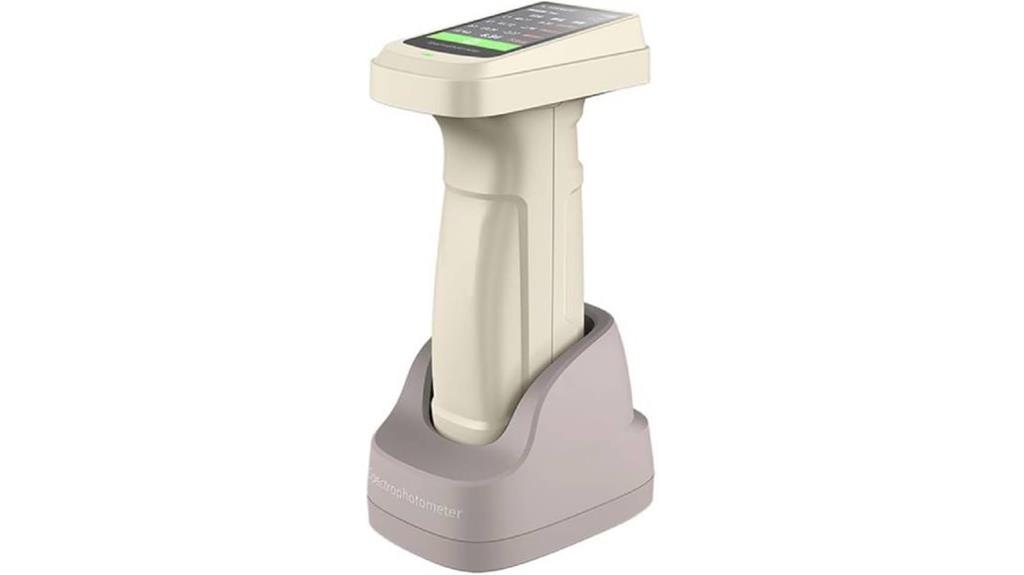
If you’re looking for a portable solution to measure color with high accuracy and speed, the JDY-F2100/2200/2300 UV Spectrometer Analyzer is an excellent choice. This handheld device offers automatic calibration, ensuring consistent results without manual intervention. It supports over 30 measurement parameters, 37 evaluation light sources, and a quick measurement time of just 1 to 1.5 seconds. With a wavelength range of 400-700nm and a measuring diameter of 8mm, it’s suitable for various sample types. Its full-color IPS display and USB compatibility make it easy to operate and integrate into different workflows, making it ideal for on-the-go color analysis.
Best For: professionals and technicians needing quick, accurate, and portable color measurement in various industries such as manufacturing, quality control, and research.
Pros:
- Supports over 30 measurement parameters and 37 evaluation light sources for comprehensive analysis.
- Automatic calibration ensures consistent and reliable results without manual intervention.
- Fast measurement speed of just 1 to 1.5 seconds with a compact, handheld design for portability.
Cons:
- Limited to a wavelength range of 400-700nm, which may not cover all specialized applications.
- The device’s advanced features and measurement capabilities may require some technical training for optimal use.
- Battery life and long-term durability are not specified, which could impact continuous field use.
Nano-500 Micro Spectrophotometer for DNA Analysis
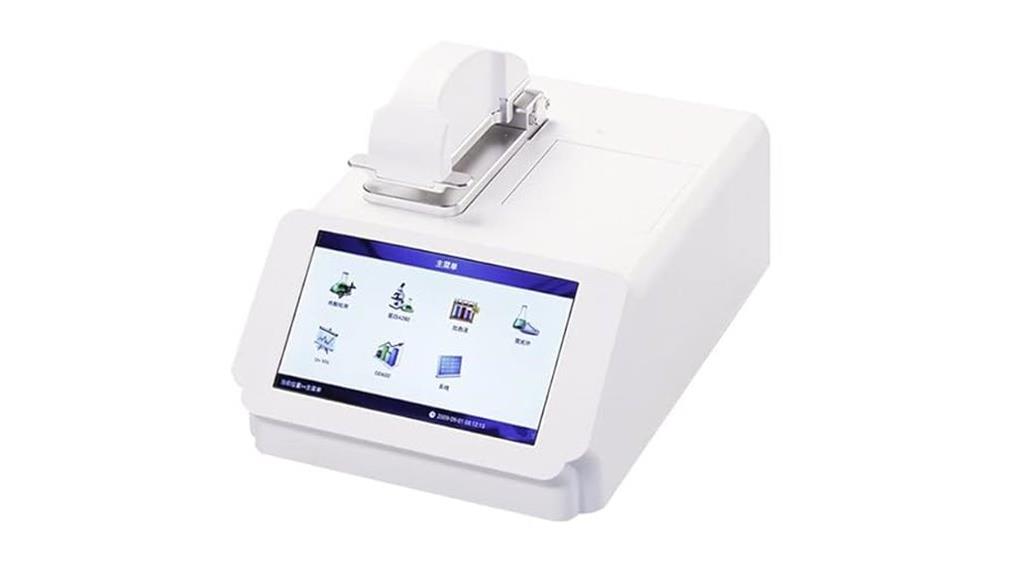
Designed for molecular biologists and laboratory professionals, the Nano-500 Micro Spectrophotometer stands out with its combination of portability and high sensitivity. Its compact size (208x320x186mm) and light weight (3.6kg) make it easy to carry and use anywhere. Equipped with a 2048-linear CCD array detector and xenon flash lamp, it detects nucleic acids ranging from 2 to 15,000 ng/μl with remarkable accuracy. It also measures DNA, RNA, and proteins at concentrations as low as 0.5 pg/μl. With a user-friendly Android interface and quick results under six seconds, it streamlines DNA analysis efficiently and reliably.
Best For: molecular biologists and laboratory professionals seeking a portable, high-sensitivity DNA analysis tool for quick and accurate nucleic acid measurement.
Pros:
- Compact and lightweight design for easy portability and use anywhere
- Rapid detection time under 6 seconds with high-resolution data acquisition
- Highly sensitive detection capable of measuring DNA, RNA, and proteins at low concentrations (as low as 0.5 pg/μl)
Cons:
- Limited to nucleic acid and protein analysis; not suitable for other biomolecules
- Requires a power source and space for operation, which may be a constraint in very small labs
- Initial cost may be high for budget-constrained facilities
Factors to Consider When Choosing X‑Ray Fluorescence Analyzers
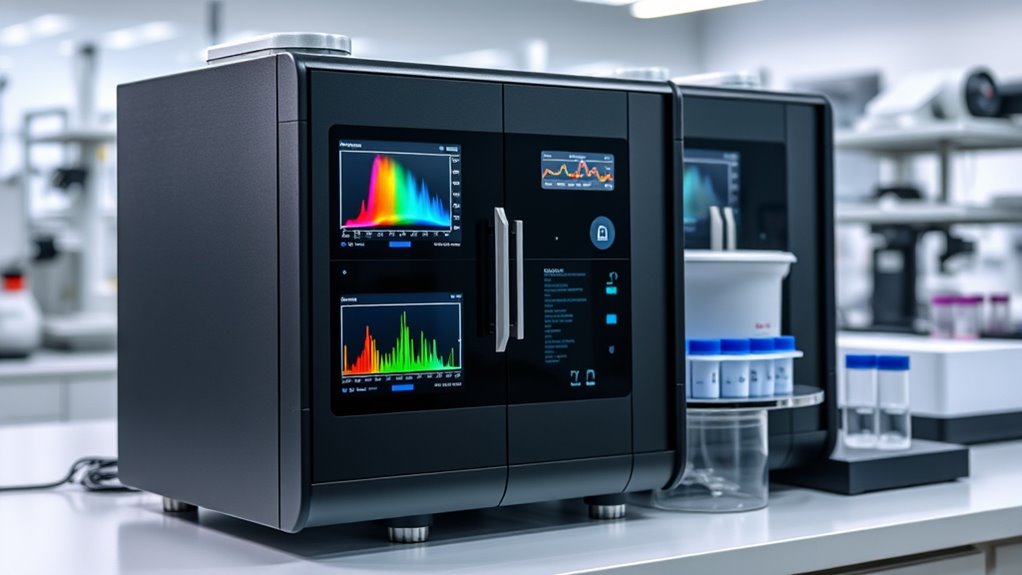
When choosing an X-ray fluorescence analyzer, I consider factors like measurement range and sensitivity to guarantee accurate results. Portability and size matter if I need to work in the field, while speed and efficiency can save valuable time. Additionally, I look at power options and data connectivity to keep my workflow seamless and reliable.
Measurement Range and Sensitivity
Choosing the right X-ray fluorescence (XRF) analyzer hinges on understanding its measurement range and sensitivity. The measurement range defines which elements it can detect, from trace levels to major components, allowing for thorough analysis in a single test. Sensitivity indicates how well the device can identify low concentrations, often expressed in parts per million (ppm) or detection limits. High sensitivity is crucial when analyzing trace elements or impurities accurately. A broader measurement range provides versatility across different sample types and concentrations, while high sensitivity ensures precise quantification of small amounts. Balancing these two factors is essential to achieve reliable, accurate results. Selecting an analyzer with the appropriate combination of measurement range and sensitivity ensures it meets your specific analytical needs efficiently.
Device Portability and Size
Device portability and size are critical factors that influence how and where you can use an X-ray fluorescence analyzer. Portable models typically weigh between 1 to 15 pounds, making them ideal for fieldwork and on-site testing. Compact designs often measure less than 12 inches in length, allowing easy handling and transportation in tight spaces. Handheld devices enable rapid analysis without bulky equipment or external power sources, boosting operational flexibility. Larger, benchtop units are less portable but offer greater stability and often include wheels or carrying cases for easier movement. The device size directly impacts its suitability for various environments—industrial sites, labs, or retail settings—determining how seamlessly you can integrate the analyzer into your workflow. Choosing the right size ensures [reliable/peak] performance and convenience in your specific application.
Analytical Speed and Efficiency
The speed at which an X-ray fluorescence analyzer delivers results directly influences workflow efficiency and decision-making, especially in fast-paced industrial environments. Some models can produce multi-element results in as little as 0.8 seconds, enabling rapid on-site assessments. This quick turnaround helps reduce reliance on laboratory testing, accelerating processes in sectors like mining, recycling, and quality control. High-efficiency analyzers often include automated calibration and fast spectrum acquisition, minimizing downtime and boosting productivity during continuous operation. However, speed must not come at the expense of accuracy; ultra-fast models should still provide precise, reliable data. Optimized data processing algorithms also play a vital role, reducing analysis time while delivering comprehensive multi-element and alloy composition information. Balancing speed and accuracy is key when selecting a high-performance analyzer.
Power Supply and Battery Life
Selecting an X-ray fluorescence analyzer with a reliable power supply is essential for maintaining consistent performance, especially in field conditions where access to mains power may be limited. I look for models with versatile power options, like AC mains compatibility and rechargeable batteries, to guarantee uninterrupted operation. Battery life is critical—I prefer devices with at least 4-6 hours of portable testing to reduce downtime. Quick recharge times and multiple charging options, such as USB or car chargers, add flexibility for on-the-go use. Built-in power management features like automatic shutoff or energy-saving modes help extend battery life. In conclusion, I verify that the power system complies with safety standards and remains stable across different temperature and humidity conditions relevant to my work environment.
Data Management and Connectivity
Reliable data management and connectivity options are essential when choosing an X-ray fluorescence analyzer, especially if I need to share results quickly or work remotely. I look for devices that offer seamless data transfer through USB, WiFi, Bluetooth, or Ethernet, ensuring efficient connectivity. Real-time data synchronization with mobile devices or cloud platforms is pivotal for remote access and analysis. Integrated features like report generation, ample storage, and export formats such as PDF or Excel help streamline workflows. Compatibility with Laboratory Information Management Systems (LIMS) is a bonus, allowing centralized data tracking. Additionally, automatic data logging, timestamping, and customizable fields improve accuracy and traceability. These features make data management more efficient, dependable, and adaptable to various work environments.
Industry Certifications and Safety
When choosing an X-ray fluorescence analyzer, paying attention to industry certifications and safety features is crucial because they guarantee the device meets rigorous standards for performance and user protection. Certifications like CE, FCC, ISO 17025, and ASTM E1508 ensure the analyzer complies with international safety and quality benchmarks. Safety features such as triple radiation shielding and auto-shutdown mechanisms are essential for minimizing radiation exposure during operation. Compliance with these standards reduces legal risks and makes the device suitable for regulated environments. Certifications also indicate that the analyzer has undergone thorough testing for electromagnetic compatibility and electrical safety. Prioritizing certified devices helps prevent accidents and guarantees reliable, safe operation in industrial and laboratory settings, giving both users and organizations peace of mind.
Frequently Asked Questions
How Do XRF Analyzers Differ in Detecting Various Metal Alloys?
XRF analyzers differ in detecting various metal alloys mainly through their energy resolution and calibration. I’ve found that high-resolution devices can distinguish between alloys with similar compositions more accurately. They also use specific calibration standards for different metals, which improves accuracy. Additionally, some models have advanced software that helps identify subtle differences in alloy compositions, making them more suitable for precise applications.
What Safety Precautions Are Necessary When Operating Portable X-Ray Devices?
When operating portable X-ray devices, I always wear appropriate protective gear like lead aprons and safety glasses to shield myself from radiation. I guarantee the device is properly calibrated and follow manufacturer guidelines to minimize exposure. I keep a safe distance, avoid unnecessary exposure to others, and never operate the device in enclosed spaces without adequate ventilation. Regular training helps me stay updated on safety protocols to protect myself and others.
How Does Environmental Temperature Affect XRF Analyzer Accuracy?
Environmental temperature critically impacts XRF analyzer accuracy. When temperatures are too high or too low, the device’s electronics and detectors can drift, leading to unreliable readings. I always guarantee the analyzer is used within the recommended temperature range, and I let it acclimate to room temperature before testing. Proper calibration and maintenance also help mitigate temperature-related inaccuracies, ensuring precise and consistent results in the field.
Can Handheld XRF Analyzers Analyze Non-Metallic Materials?
Yes, handheld XRF analyzers can analyze non-metallic materials. I’ve used them on ceramics, plastics, and minerals with great results. These devices are versatile, thanks to adjustable settings that optimize detection for different sample types. While metals are their primary focus, modern handheld XRF analyzers are increasingly capable of providing accurate readings on various non-metallic substances, making them valuable tools across multiple industries.
What Is the Typical Lifespan of an XRF Analyzer With Regular Use?
On average, an XRF analyzer lasts about 5 to 10 years with regular use. I’ve seen some models operate reliably for over a decade when properly maintained. Notably, handheld analyzers tend to have shorter lifespans—around 3 to 7 years—due to their frequent handling. Proper care, like regular calibration and avoiding harsh environments, can extend your device’s lifespan, ensuring you get the most value from your investment.
Conclusion
Choosing the right X-ray fluorescence analyzer is like selecting a trusted compass for a journey—each one guides you through a sea of data with precision and confidence. Whether you’re hunting for precious metals or analyzing minerals, these tools are your navigational stars. Remember, the best analyzer isn’t just a device; it’s your partner in discovery, turning complex data into clear, shining insights that illuminate your path forward.
